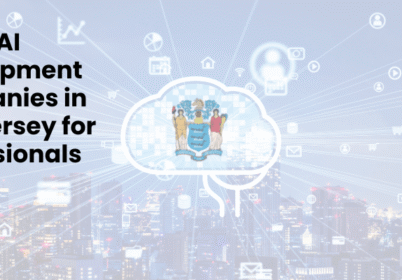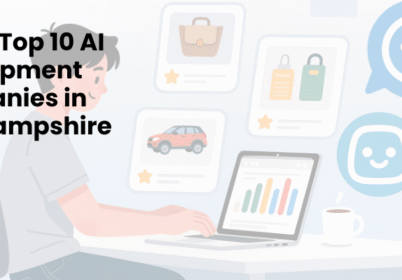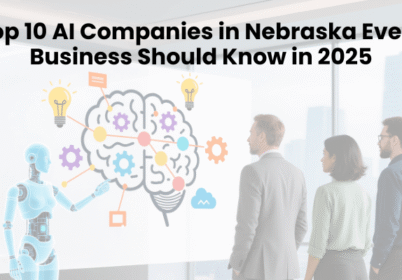How to Build Your Own AI Assistant: A Complete Step-by-Step Guide for 2025

Table of Contents
AI voice assistants have transformed our daily interactions with technology, becoming integral parts of our homes and workplaces. These intelligent systems now efficiently manage schedules, answer complex questions, and control smart devices with impressive accuracy. Learning how to make your own AI assistant has become increasingly accessible for developers and technology enthusiasts with various skill levels. The underlying technology has evolved dramatically from basic command-response systems to sophisticated conversational agents that understand context and nuance. This comprehensive guide explains how to make your own AI assistant using either existing frameworks or building from scratch. We will explore all essential components, key technologies, and development processes required for creating truly functional AI assistants. The journey from initial concept to final deployment involves several critical stages that effectively combine programming, machine learning, and thoughtful user experience design. Understanding these fundamental elements will empower you to create assistants perfectly tailored to specific needs and user preferences.
Key Takeaways:
– Readers will learn how AI assistants work, from natural language processing to intent recognition, and how these components interact to enable smooth, human-like conversations.
– understand the various types of AI assistants—command-based, domain-specific, multi-modal—and why starting with a narrow focus is often the most effective path for developers.
– The guide walks through step-by-step instructions on how to plan, build, test, and deploy a custom AI assistant using modern tools like TensorFlow, Dialogflow, and TTS APIs.
– Readers will grasp the advantages of building their own assistant, such as stronger data privacy, brand alignment, deeper system integration, and task-specific optimization.
– The article outlines best practices in voice assistant development, emphasizing privacy, conversational design, accessibility, and future-proofing through modular architecture and scalable systems.
Table of Contents
What is AI Assistant? Understanding AI Assistants
AI assistants are sophisticated software applications designed to understand human language and perform various tasks through natural conversation. These digital helpers process language through complex algorithms that accurately interpret user intent and conversational context. Most modern assistants operate through voice interfaces like smart speakers or text interfaces such as messaging platforms and websites. The core technology powering AI assistants includes natural language processing, machine learning models, and comprehensive knowledge databases. These intelligent systems continuously improve through ongoing user interactions by analyzing conversation patterns and refining response accuracy over time. Well-designed AI assistants can schedule important appointments, answer detailed questions, control connected smart devices, and integrate seamlessly with various digital services. The intelligence level varies significantly depending on underlying models, training data quality, and processing capabilities. Some assistants focus exclusively on specific domains like healthcare or customer service with deeply specialized knowledge. Others function as versatile general-purpose helpers capable of addressing diverse queries across numerous subject areas with reasonable competence. The meaningful distinction between simple chatbots and advanced AI assistants lies primarily in contextual understanding and adaptive learning capabilities. True AI assistants effectively maintain conversation history and gradually adapt to user preferences through continuous learning from interactions.
Types of AI Assistants
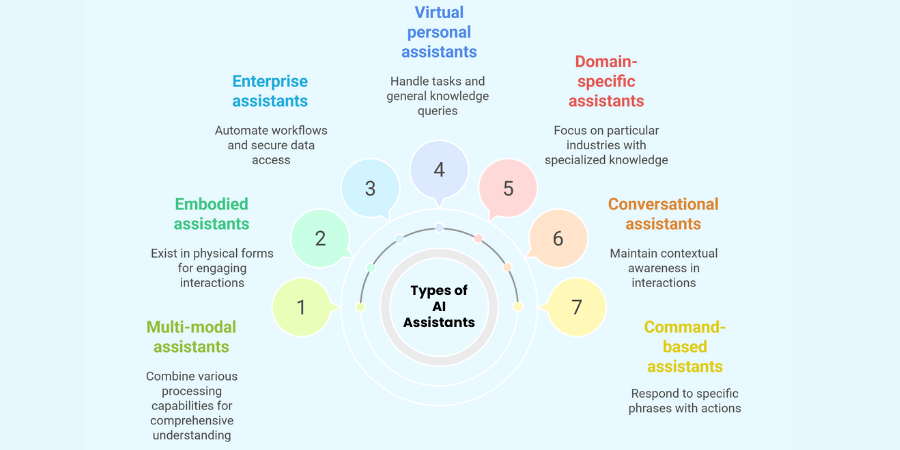
- Command-based assistants represent the simplest form, responding to specific predefined phrases with predetermined actions or responses.
- Conversational assistants employ sophisticated natural language understanding to maintain meaningful contextual awareness throughout extended interactions.
- Domain-specific assistants focus exclusively on particular industries like healthcare, finance, or legal services with highly specialized knowledge.
- Virtual personal assistants like Siri and Alexa combine multiple capabilities to handle everyday tasks and general knowledge queries.
- Enterprise assistants integrate with complex business systems to automate workflows and securely access company data repositories.
- Embodied assistants exist in physical forms like interactive robots or animated avatars for more engaging human-computer interactions.
- Multi-modal assistants effectively combine text, voice, and visual processing capabilities for more comprehensive understanding of user intent.
Why Create Your Own AI Assistant: Key Benefits
Custom AI assistants deliver truly personalized experiences tailored precisely to specific user needs and unique preferences. This meaningful customization extends far beyond simple interface adjustments to fundamental functionality and specialized knowledge domains. Forward-thinking businesses gain significant competitive advantages through proprietary assistants that authentically embody their brand voice and specialized expertise.
These branded experiences strengthen valuable customer relationships through consistent, high-quality interactions across all digital touchpoints. Legitimate data privacy concerns diminish considerably when organizations maintain complete control over their assistant technology and implementation. Companies can ensure sensitive information remains properly protected without sharing valuable data with third-party assistant providers. Integration capabilities expand dramatically with custom assistants specifically designed to work seamlessly with existing internal systems. These purpose-built solutions connect effortlessly with proprietary databases, legacy software systems, and specialized industry tools.
Development costs have decreased substantially as powerful open-source frameworks and pre-trained models become widely available to developers. Organizations can now build sophisticated assistants without requiring massive investments in fundamental AI research or expensive infrastructure. Exciting innovation opportunities emerge when businesses can rapidly prototype and deploy new assistant features without external dependencies. This technological agility enables companies to respond quickly to changing market conditions and evolving customer needs. Workflow automation reaches unprecedented efficiency levels through assistants designed for specific operational processes and business requirements.
Custom assistants understand company-specific terminology, established procedures, and internal systems for truly relevant support. Accessibility improves significantly as organizations create specialized assistants that address the unique needs of their specific user base. Custom voice models, specialized vocabulary options, and tailored interaction patterns enhance usability for diverse audience segments.
Important Tools and Technologies for Making an AI Voice Assistant
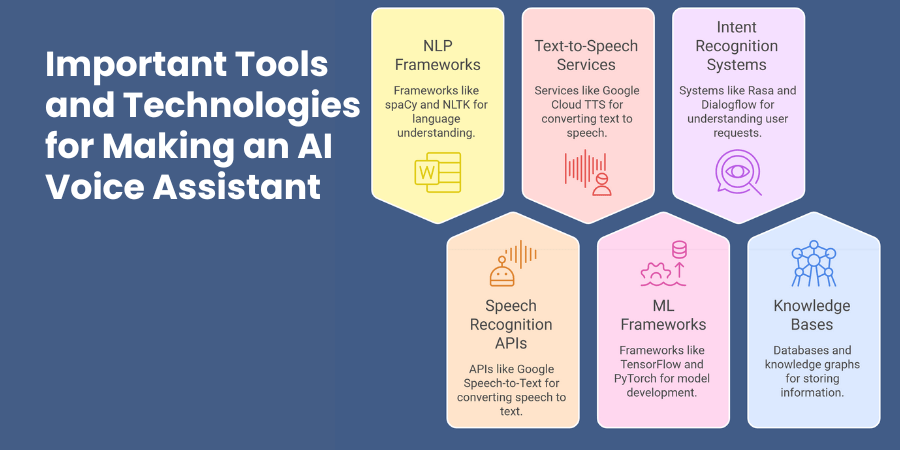
Essential technologies for building effective AI voice assistants include:
- Natural Language Processing frameworks like spaCy, NLTK, and powerful Transformers libraries for language understanding
- Speech recognition APIs such as Google Speech-to-Text, Amazon Transcribe, and open-source Mozilla DeepSpeech
- Text-to-Speech services including Google Cloud TTS, Amazon Polly, and the customizable Mozilla TTS
- Machine learning frameworks like TensorFlow, PyTorch, and scikit-learn for model development and training
- Intent recognition systems such as Rasa, Dialogflow, and LUIS for understanding user requests
- Knowledge bases ranging from simple structured databases to sophisticated knowledge graphs with semantic relationship mapping
Supporting tools for comprehensive development include integrated development environments, reliable cloud platforms, efficient voice activation technologies, and flexible integration APIs. These essential components work together harmoniously to create a functional and highly responsive AI assistant system.
Core Features of an AI Voice Assistant
Accurate speech recognition capability transforms spoken language into text with remarkable precision across diverse accents and environments. Modern systems achieve near-human performance through sophisticated deep learning models trained on diverse multilingual speech samples. Advanced natural language understanding interprets the deeper meaning behind user statements beyond simple keyword matching and pattern recognition. This comprehensive comprehension includes detecting emotional sentiment, extracting named entities, and identifying complex relationships between interconnected concepts.
Effective context management maintains relevant conversation history to provide appropriate responses based on previous exchanges and established context. This critical feature enables natural multi-turn dialogues where users can refer comfortably to previously mentioned subjects. Precise intent classification determines exactly what users want to accomplish through their various queries or specific commands. Accurate intent detection ensures consistently appropriate responses even when requests use widely varied phrasing or terminology. Reliable entity extraction identifies specific objects, people, locations, dates, or numerical values mentioned within user queries.
This essential capability allows assistants to gather all necessary information for completing assigned tasks effectively. Sophisticated dialogue management controls conversation flow through appropriate responses, clarifying questions, and natural follow-up prompts. This system handles unexpected interruptions, necessary clarifications, and smooth topic transitions during extended interactive conversations. Natural voice synthesis generates pleasant, human-like speech that conveys information clearly with appropriate emotional expression. Modern text-to-speech systems produce increasingly natural voices with proper intonation, emphasis, and regional accent options. Comprehensive multi-language support enables meaningful interactions in various languages through accurate translation and culturally appropriate localized responses.
Truly global assistants require robust multilingual capabilities to serve increasingly diverse user populations effectively. Intelligent personalization adapts responses based on individual user preferences, interaction history, and established behavior patterns. This thoughtful customization creates more relevant experiences carefully tailored to individual needs and personal habits. Extensive third-party integrations connect assistants to external services, popular applications, and compatible smart devices. These valuable connections significantly expand functionality well beyond the assistant’s core built-in capabilities.
Best Use Cases of AI
AI assistants have evolved far beyond simple voice commands. Today, they streamline tasks, enhance productivity, and offer industry-specific support in real time. From customer service to personal scheduling and healthcare, AI assistants are transforming the way we work and live. In this article, we explore the best AI assistant use cases across various industries with real-world examples.
1. Customer Support Automation
Overview:
AI assistants are widely used to automate customer service, handling queries 24/7 with speed and consistency.
Industries Served:
E-commerce, telecom, finance, SaaS platforms, and hospitality benefit most from AI-driven customer support.
How It Works:
AI assistants use natural language processing (NLP) to understand customer queries and respond contextually. They integrate with CRM systems to personalize answers and escalate complex issues to human agents when needed.
Impact:
Reduces wait times, enhances customer satisfaction, lowers support costs, and ensures consistency in service delivery.
Real-World Example:
H&M uses an AI chatbot on its website and mobile app to help users with order tracking, returns, and product recommendations.
2. Personal Scheduling and Productivity Boost
Overview:
AI assistants manage schedules, set reminders, and automate repetitive tasks for busy professionals.
Industries Served:
Corporate professionals, freelancers, education, and health professionals.
How It Works:
Voice or text-based assistants like Google Assistant or Microsoft Copilot sync with calendars, email, and task apps. They schedule meetings, send reminders, and even draft responses or documents.
Impact:
Saves hours weekly, minimizes human errors, and helps users focus on higher-value tasks.
Real-World Example:
Microsoft 365 Copilot integrates with Outlook and Teams to summarize meetings, schedule follow-ups, and draft emails automatically.
3. Healthcare Virtual Assistants
Overview:
AI assistants support patients and healthcare professionals through appointment booking, symptom checking, and health monitoring.
Industries Served:
Hospitals, telemedicine platforms, insurance providers, and health apps.
How It Works:
AI-powered assistants ask users about their symptoms, analyze the input using medical databases, and suggest potential next steps. Some integrate with wearable devices for real-time health tracking.
Impact:
Improves patient engagement, reduces administrative burden, and provides faster access to care.
Real-World Example:
Babylon Health’s AI assistant helps users assess symptoms and book doctor appointments through their app
4. AI Assistants for HR and Recruitment
Overview:
HR teams leverage AI assistants to screen candidates, schedule interviews, and answer employee FAQs.
Industries Served:
IT companies, recruitment agencies, enterprises, and startups.
How It Works:
AI assistants process resumes, match job descriptions, and automate interview scheduling. They also provide onboarding support and policy clarification through internal chatbots.
Impact:
Shortens hiring cycles, enhances candidate experience, and reduces administrative workload on HR teams.
Real-World Example:
Unilever uses an AI assistant named “HireVue” to assess video interviews using facial analysis and speech patterns, saving thousands of hours in recruitment.
5. AI Assistants in Sales Enablement
Overview:
Sales teams use AI assistants for lead qualification, personalized outreach, and real-time sales support.
Industries Served:
B2B SaaS, real estate, insurance, and e-commerce.
How It Works:
AI tools analyze customer data, qualify leads, suggest follow-ups, and even generate sales pitches tailored to client behavior.
Impact:
Boosts conversion rates, reduces time spent on low-quality leads, and increases revenue through smarter engagement.
Real-World Example:
Conversica offers an AI sales assistant that engages with leads via email or SMS and notifies reps when a lead is sales-ready.
A Step-by-Step Guide to Building an AI Voice Assistant
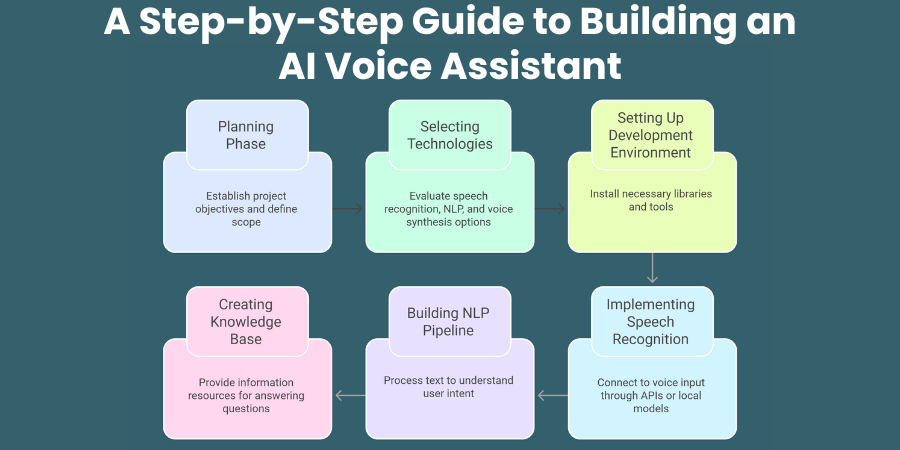
Building a functional AI voice assistant involves these essential sequential steps:
- Planning phase: Establish clear project objectives and carefully define the assistant’s intended scope and specific capabilities
- Selecting technologies: Thoroughly evaluate available speech recognition options, NLP frameworks, and voice synthesis technologies
- Setting up development environment: Install all necessary libraries, frameworks, and appropriate development tools
- Implementing speech recognition: Connect your assistant to reliable voice input through established APIs or efficient local models
- Building NLP pipeline: Process incoming text to understand user intent, extract relevant entities, and determine appropriate responses
- Creating knowledge base: Provide comprehensive information resources for accurately answering questions and supporting various tasks
The development process continues with implementing robust dialogue management, configuring natural voice synthesis, conducting thorough testing, and planning strategic deployment. Each development stage requires careful consideration of technical requirements and important user experience factors.
Best Practices to Follow When Building an AI Voice Assistant
Prioritize user privacy by implementing strong data protection measures and maintaining completely transparent privacy policies. Clearly communicate what specific data is collected, how it is used, and provide straightforward options for data deletion.
Design natural conversations with appropriate turn-taking mechanics and genuine contextual awareness throughout interactions. Avoid robotic-sounding responses by incorporating conversational markers and implementing adaptive dialogue patterns that feel human. Implement robust error handling mechanisms that gracefully manage inevitable misunderstandings and provide clear recovery paths. When recognition fails, assistants should offer helpful alternatives rather than repeating frustrating error messages. Focus intensely on accessibility by supporting multiple interaction modes and accommodating diverse user needs and abilities.
Consider users with different physical abilities, varying technical proficiency levels, and challenging environmental constraints. Continuously improve performance through systematic analysis of actual user interactions and key performance metrics. Regular model updates and thoughtful response refinements based on real usage patterns enhance overall effectiveness. Maintain consistent personality and conversational tone carefully aligned with your brand values and established user expectations. A well-defined assistant persona creates more engaging and predictably satisfying user experiences over time.
Optimize response times by thoughtfully balancing processing requirements with reasonable user experience expectations and limitations. Users typically expect responses within 1-2 seconds for maintaining satisfying conversational flow. Design for future scalability from the beginning to accommodate growing user bases and expanding feature requirements. Modular architecture significantly facilitates adding new capabilities without disrupting existing functionality or performance. Implement comprehensive security measures including proper authentication protocols, data encryption, and secure API handling practices. Protection against potential vulnerabilities prevents unauthorized access or malicious manipulation of the assistant system.
Provide clear onboarding instructions that help new users understand available capabilities and effective interaction patterns. Setting appropriate expectations reduces potential frustration and increases successful interaction completion rates. Create thoughtful fallback strategies for handling requests beyond the assistant’s current capabilities or knowledge boundaries. Graceful handoffs to human support or alternative information resources maintain consistently positive user experiences.
Most Popular AI Voice Assistants
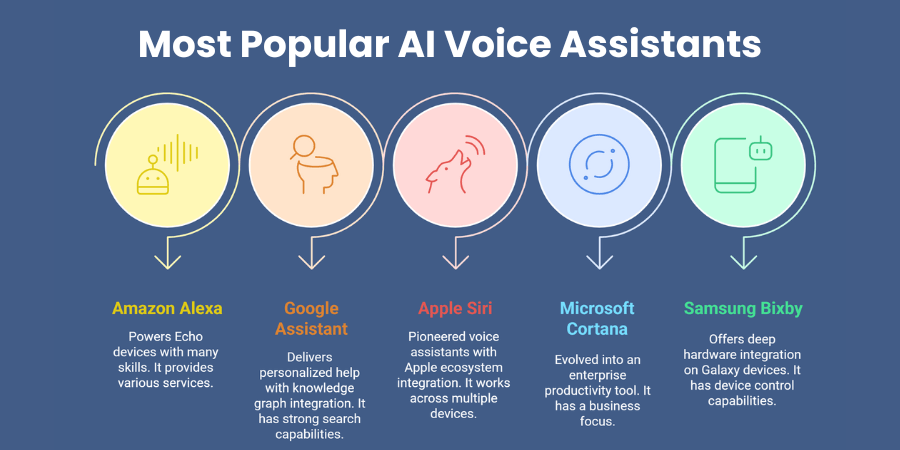
The current market features several well-established AI voice assistants with distinct capabilities and ecosystems:
- Amazon Alexa powers millions of Echo devices worldwide with over 100,000 skills for various services
- Google Assistant delivers highly personalized help with strong knowledge graph integration and search capabilities
- Apple Siri pioneered mainstream voice assistants with deep Apple ecosystem integration across multiple devices
- Microsoft Cortana evolved strategically from consumer assistant to enterprise productivity tool with business focus
- Samsung Bixby offers particularly deep hardware integration on Galaxy devices with device control capabilities
Additionally, IBM Watson Assistant provides enterprise-grade conversational AI solutions, while open-source alternatives like Mycroft offer privacy-focused options. Specialized industry assistants serve specific professional domains with highly targeted expertise and capabilities.
Conclusion
Creating your own AI assistant represents a significant opportunity in today’s rapidly evolving technology landscape. The development process effectively combines multiple disciplines including natural language processing, machine learning, and thoughtful user experience design. Learning how to make your own
AI assistant empowers developers to create truly personalized solutions for specific needs. These custom assistants can address particular requirements that general-purpose commercial options frequently overlook or handle poorly. The development journey requires careful planning, appropriate technology selection, and continuous refinement based on actual user feedback. Forward-thinking organizations gain meaningful competitive advantages through proprietary assistants that authentically embody their unique expertise and established brand voice.
As AI technologies continue advancing rapidly, custom assistants will become increasingly sophisticated and remarkably capable. The growing accessibility of powerful development tools makes this exciting field more approachable than ever before. Whether building completely from scratch or leveraging existing frameworks, the path to creating effective AI assistants becomes increasingly accessible.
The future belongs to innovative creators who can effectively harness these transformative technologies to solve meaningful problems and enhance human capabilities. By understanding the fundamental components and structured development processes, you can confidently join the growing community of successful AI assistant creators.
Frequently Asked Questions
What programming languages are best for building AI assistants?
Python dominates AI assistant development due to its extensive machine learning libraries and powerful natural language processing tools. JavaScript offers significant advantages for web-based assistants with frameworks like Rasa.js and strong integration capabilities. Both languages provide robust ecosystem support with numerous pre-built components and highly active developer communities.
How much computing power is needed to run a custom AI assistant?
Basic text-based assistants can run efficiently on standard computers with minimal resources for simple pattern matching operations. Voice-enabled assistants require noticeably more processing power for handling speech recognition and synthesis functions effectively. Advanced assistants using large language models may need dedicated GPU acceleration for acceptable performance and reasonable response times.
Can I build an AI assistant without coding experience?
No-code platforms like Voiceflow, Botpress, and Dialogflow enable assistant creation through intuitive visual interfaces without requiring programming knowledge. These accessible platforms handle complex technical aspects while users focus primarily on conversation design and content creation. However, customization capabilities remain somewhat limited compared to traditional code-based development approaches for specialized applications.
How do I make my AI assistant understand specific industry terminology?
Custom training data incorporating industry-specific terms and concepts significantly improves recognition accuracy for specialized vocabulary. Entity extraction models can be carefully fine-tuned with domain vocabulary and common relationship patterns. Comprehensive knowledge bases containing specialized information provide essential context for correctly interpreting industry-specific queries and requests.
What are the main privacy concerns when developing AI assistants?
Data collection practices require completely transparent policies regarding what specific information is gathered and how it is stored. Voice recording handling presents particular sensitivity concerns regarding biometric data security and private conversation content. Third-party service dependencies may introduce additional data sharing considerations beyond your direct control and oversight.
Shaif Azad
Related Post
Top 10 AI Development Companies in New Jersey for Business
Are you searching for the perfect AI development partner in New Jersey? Have you wondered which...
Top 10 AI Development Companies in New Hampshire
Are you watching New Hampshire’s tech landscape transform before your eyes? Your state is quietly becoming...
Top AI Companies in Nebraska Every Business Should Know
Are you a Nebraska business owner wondering how artificial intelligence could transform your operations? Picture this...

